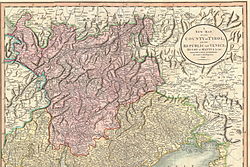
Back كونتية تيرول Arabic Comtat del Tirol Catalan Tyrolské hrabství Czech Gefürstete Grafschaft Tirol German Condado de Tirol Spanish Tirooli krahvkond ET کنتنشین تیرول FA Comté de Tyrol French רוזנות טירול HE Grafschaft Tirol ID
This article needs additional citations for verification. (December 2024) |
(Princely) County of Tyrol | |||||||||||||||
|---|---|---|---|---|---|---|---|---|---|---|---|---|---|---|---|
| 1140–1919 | |||||||||||||||
 Map of the County of Tyrol (1799) | |||||||||||||||
| Status | State of the Holy Roman Empire (until 1806), Crown land of the Habsburg monarchy, of the Austrian Empire (from 1804) and of Cisleithanian Austria-Hungary (from 1867) | ||||||||||||||
| Capital | Meran, formally until 1848 Innsbruck, residence from 1420 | ||||||||||||||
| Common languages | |||||||||||||||
| Government | County | ||||||||||||||
| Historical era | Middle Ages | ||||||||||||||
• Created County | 1140 | ||||||||||||||
• Bequeathed to House of Habsburg | 1363 | ||||||||||||||
• Joined Austrian Circle | 1512 | ||||||||||||||
| 1803 | |||||||||||||||
• Restored to Austria | 1814 | ||||||||||||||
• Partitioned by Treaty of St Germain | September 10, 1919 | ||||||||||||||
| |||||||||||||||
| History of Austria |
|---|
 |
|
|
The (Princely) County of Tyrol was an estate of the Holy Roman Empire established about 1140. After 1253, it was ruled by the House of Gorizia and from 1363 by the House of Habsburg. In 1804, the County of Tyrol, unified with the secularised prince-bishoprics of Trent and Brixen, became a crown land of the Austrian Empire. From 1867, it was a Cisleithanian crown land of Austria-Hungary.
Today the territory of the historic crown land is divided between the Italian autonomous region of Trentino-Alto Adige/Südtirol and the Austrian state of Tyrol. The two parts are today associated again in the Tyrol–South Tyrol–Trentino Euroregion.

